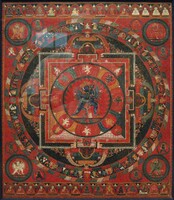Hevajra Holding Weapons

Shastradhara (weapon holding) Hevajra is described in the Samputa Tantra - a shared explanatory Tantra of the Hevajra Root Tantra. Aside from the Samputa Tantra, the most common reference and ritual source for the Shastradhara form of Hevajra is the Vajravali text of Abhayakaragupta.
The principal Tantric practice of Marpa Chokyi Lodro (1012-1096) is said to have been the deity Hevajra and specifically the Shastradhara form. The Shastradhara form was available through other sources of lineage transmission in Tibet and the Himalayas prior to the introduction of the Vajravali text in the 13th century.
Visually there are two main differences between the Hevajra Tantra form of the deity and the Samputa Tantra form of the deity. The first difference is in the mandala configuration where the Hevajra Tantra version is called a nine deity mandala and the Samputa version is a seventeen deity mandala. In both cases the central figures of Hevajra and Nairatmya are counted as one. In the Samputa Tantra, to account for the larger mandala size, eight additional retinue figures are described: four door keepers and four intermediate direction figures. Second, the retinue goddesses in the Hevajra Tantra each have two arms while in the Samputa Tantra the goddesses have four arms each.
See the essential components of a Hevajra mandala with numbered and labeled figures and colour coded sections.
